
Abandoned & Little-Known Airfields:
Central Oklahoma
© 2002, © 2016 by Paul Freeman. Revised 9/26/16.
This site covers airfields in all 50 states: Click here for the site's main menu.
____________________________________________________
Please consider a financial contribution to support the continued growth & operation of this site.
(Original) Ardmore Municipal Airport (revised 9/12/15) - Curtiss-Wright Field / (Original) Wiley Post Airport (revised 11/25/15)
Ditch Witch Airfield (revised 9/14/16) - Downtown Airpark (revised 9/26/16) - Hickok Country Club Airport (revised 4/10/14)
Northeast 63rd Street Airport / Expressway Junction Airpark (revised 4/23/16) - Shawnee Municipal Airport #2 (revised 4/23/16)
Twelfth Street Airpark (revised 9/26/16) - Wheatley Airport / Barkhurst Field (revised 11/5/14)
____________________________________________________
Ditch Witch Airfield, Perry, OK
36.296, -97.318 (North of Oklahoma City, OK)

The Ditch Witch Airfield, as depicted on the 1972 USGS topo map.
According to a local resident, “This manufacturing concern under the direction of Ed Malzahn created the world leading trench/boring equipment in the town of Perry.
The asphalt strip was there from early 1960s.
I knew the pilot he had on staff. They a larger hangar & a King Air.
The pilot told the story about one time while taking off to the north - 2 B-52s were being flown from Tinker to McConnell AFB at low altitude.
He did not see them & came up under them pretty close. Said he had return back to change his shorts.
Mr. Malzahn loved to fly & the pilot got lots of hours.
Oklahoma Highway Patrol used to land there for coffee at a local coffee shop.”
The earliest depiction which has been located of Ditch Witch Airfield was on the 1972 USGS topo map.
It depicted a single unpaved north/south runway, with a long taxiway leading toward the factory to the southeast.

The earliest photo which has been located of the Ditch Witch Airfield was a 1995 USGS aerial view looking northeast.
The airfield had evidently gained a paved runway at some point between 1972-95,
and a paved taxiway (on which “Ditch Witch” was painted in large letters) led to a ramp & hangar on the southeast side.

The last photo which has been located showing the Ditch Witch Airfield still painted with active runway markings was a 2011 aerial view looking southeast.
According to a local resident, “The asphalt strip was cleared in the early 2010s.”

A 2015 aerial view looking southeast at the Ditch Witch Airfield showed the majority of the runway pavement had been removed,
but the “Ditch Witch” lettering was still visible on the taxiway.
The site of Ditch Witch Airfield is located northeast of the intersection of Fir Street & 25th Street.
____________________________________________________
Wheatley Airport / Barkhurst Field, Moore, OK
35.35, -97.48 (South of Oklahoma City, OK)

Wheatley Airport / Barkhurst Field, as depicted in the 1945 AAF Airfield Directory (courtesy of Scott Murdock).
This small general aviation airport on the south side of OK City was evidently established at some point between 1938-45,
as it was not yet listed among active airfields in The Airport Directory Company's 1937 Airport Directory (courtesy of Bob Rambo)
nor depicted on the 1938 USGS topo map.
The earliest depiction which has been located of Wheatley Airport / Barkhurst Field
was a depiction in the 1945 AAF Airfield Directory (courtesy of Scott Murdock).
The directory described Wheatley Airport / Barkhurst Field as a 160 acre square property
having 2 sod runways, measuring 2,400' north/south & 2,100' east/west.
The field was said to have 3 hangars, of which the largest was a 82' x 70' steel structure.
Wheatley Airport / Barkhurst Field was described as being owned & operated by private interests.

Wheatley Airport was depicted as a commercial/municipal airport on the 1945 OK City Sectional Chart (courtesy of Chris Kennedy).

The last aeronautical chart depiction which has been located of Wheatley Airport was on the 1949 OK City Sectional Chart (courtesy of John Price),
which depicted Wheatley as having a 2,400' unpaved runway.
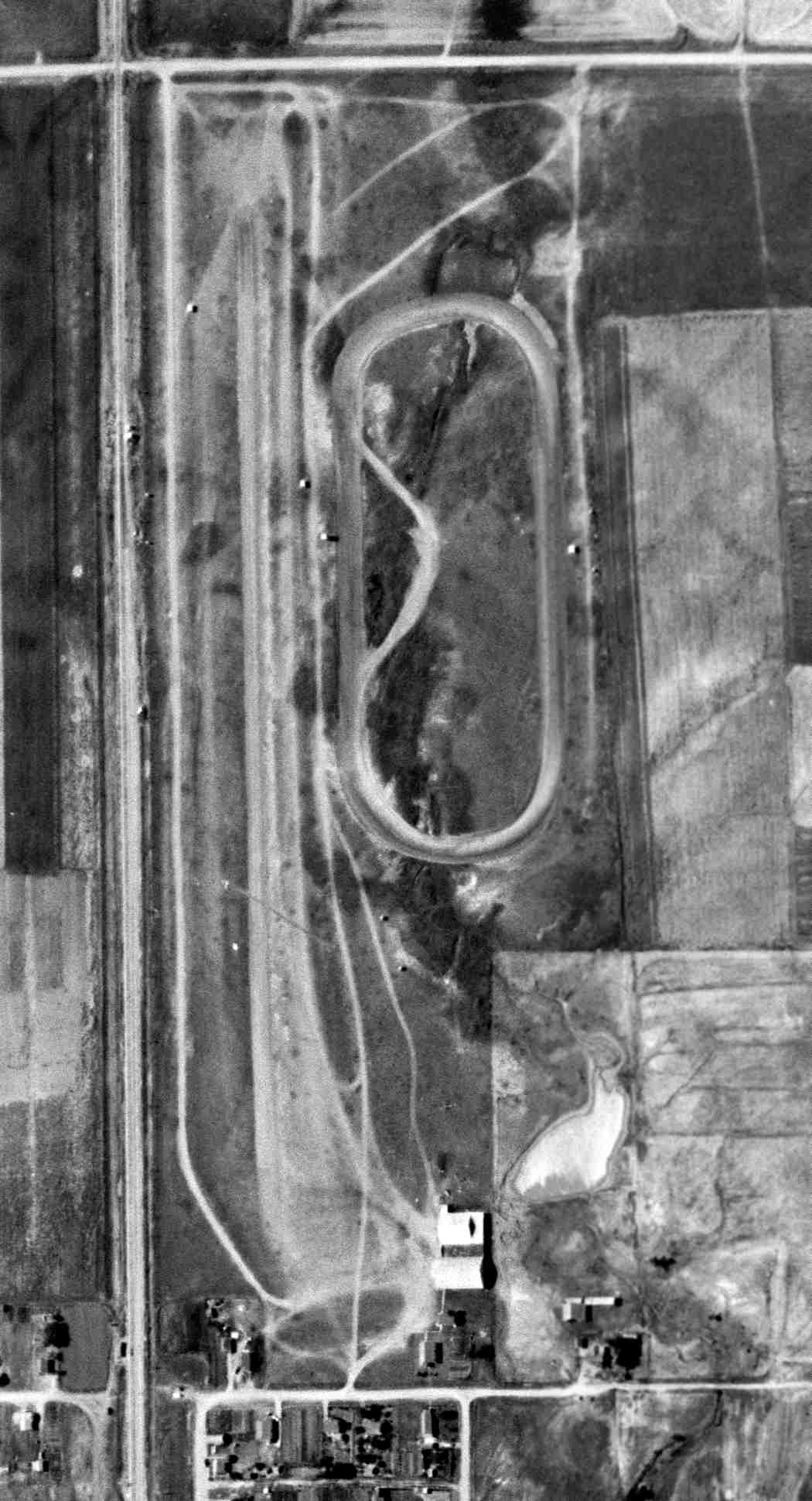
The only photo which has been located of Wheatley Airport was a 6/25/54 USGS aerial view.
It depicted a north/south runway, whereas the previous crosswind runway had been replaced with an oval racetrack.
Two hangars were on the southeast side of the airport, but there were no aircraft visible,
so the airport may have already been closed by that point.

The last depiction which has been located of Wheatley Airport was on the 1956 USGS topo map.
It depicted a north/south runway with a parallel taxiway on either side, labeled simply as “Landing Field”,
which may have indicated that the airport was closed by that point.
A ramp with a few small buildings was depicted on the southeast side.
Wheatley Airport was no longer depicted on the 1965 OK City Sectional Chart (courtesy of John Price),
which instead showed a new Twelfth Street Airpark on the opposite (north) side of 12th Street.
A 1995 USGS aerial photo showed a large building had been constructed on the north side of the Wheatley Airport site,
but the majority of the property remained clear.
But there was no specific recognizable remains of the airfield.

An 8/9/12 aerial view showed the site of Wheatley Airport had been covered with buildings.
The site of Wheatley Airport is located southwest of the intersection of Northeast 12th Street & Messenger Drive.
____________________________________________________
Twelfth Street Airpark, Moore, OK
35.36, -97.48 (South of Oklahoma City, OK)

Twelfth Street Airpark, as depicted on the 1965 OK City Sectional Chart (courtesy of John Price).
This small general aviation airport on the south side of OK City was evidently established at some point between 1956-65,
as it was not yet depicted on the 1956 USGS topo map.
The earliest depiction which has been located of Twelfth Street Airpark was on the 1965 OK City Sectional Chart (courtesy of John Price),
which depicted Twelfth Street as having a 2,700' unpaved runway.

The earliest photo which has been located of Twelfth Street Airpark was a 9/10/69 USGS aerial view.
It depicted 6 single-engine aircraft parked along the southeast side of a single north/south runway,
along with a cluster of small hangars on the southwest side.

The 1969 USGS topo map depicted Twelfth Street Airpark as having a north/south runway
with a row of small buildings along the southwest side.

An undated aerial view from the 1978 OK Airport Directory (courtesy of Frank Holbert)
depicted several light aircraft parked along the southeast side of Twelfth Street Airpark's north/south runway.

The last labeled depiction which has been located of Twelfth Street Airpark was on the 1986 USGS topo map.
It depicted the field in basically the same manner as was depicted on the 1969 topo map.

The last photo which has been located showing Twelfth Street Airpark still intact a 1996 USGS aerial view.
The airport may already have been closed by this point, as there were no aircraft visible on the property.
A 2002 aerial photo showed a row of small buildings (storage units?) had been built at some point between 1995-2002
to the north of the hangars.

An 8/9/12 aerial view showed no trace remaining of Twelfth Street Airpark,
with a row of small buildings (storage units?) having been built along the runway.
But some former hangars remain on the southwest side of the property.
The site of Twelfth Street Airpark is located northwest of the intersection of Northeast 12th Street & Smoking Tree Street.
____________________________________________________
Hickok Country Club Airport, Oklahoma City, OK
35.38, -97.53 (Southwest of Downtown Oklahoma City, OK)

A circa 1943-45 aerial view looking north at Hickok Country Club Airport
from the 1945 AAF Airfield Directory (courtesy of Scott Murdock).
This small general aviation airport on the south side of OK City was evidently established at some point between 1937-45,
as it was not yet listed among active airfields in The Airport Directory Company's 1937 Airport Directory (courtesy of Bob Rambo).
The earliest depiction which has been located of Hickok Country Club Airport was a circa 1943-45 aerial view
from the 1945 AAF Airfield Directory (courtesy of Scott Murdock).
It depicted Hickok as having 2 unpaved runways.
The 1945 AAF Airfield Directory (courtesy of Scott Murdock) described Hickok Country Club Airport
as a 150 acre rectangular property having 2 sod 2,100' runways, of which the north/south runway also had a 1,900' asphalt stabilized inset.
The field was said to have 2 hangars, of which the largest was a 75' square brick, wood, and metal structure.
Hickok Country Club Airport was described as being owned & operated by private interests.

Hickok Country Club Airport, as depicted on the 1945 OK City Sectional Chart (courtesy of Chris Kennedy).

The last aeronautical chart depiction which has been located of Hickok Country Club Airport was on the 1949 OK City Sectional Chart (courtesy of John Price),
which depicted Hickok Country Club as having a 2,100' unpaved runway.

The last photo which has been located of Hickok Country Club Airport was a 6/25/54 USGS aerial view.
The airport consisted of 2 unpaved runways, with 2 hangars & a T-hangar on the northwest side.
But the airport may already have been closed by this point, as there were no aircraft visible on the field.

The last depiction which has been located of Hickok Country Club Airport was on the 1955 USGS topo map.
It depicted Country Club Airport as having 2 unpaved runways, with 2 small buildings on the northwest side.
Hickok Country Club Airport was gone by 1965,
as it was no longer depicted on the 1965 OK City Sectional Chart (courtesy of John Price).
The 1970 USGS topo map just depicted a blank area on the site of Hickok Country Club Airport.
The 1976 USGS topo map depicted Brookwood Drive having been built through the southern portion of the airport site.
A 1990 USGS aerial photo showed the Brookwood North Shopping Center on the north side of the airport site,
and housing filling the southern portion.

An 8/9/12 aerial view showed no trace remaining of Hickok Country Club Airport.
Thomas Solinski recalled, “I lived in a duplex that was built on the diagonal runway! [I always] wondered why I liked living there - I was on an airport.
The apartment complex is called Country Club Village.
There used to be a miniature golf course through the wooded lake area in the middle of the picture.”
The site of Hickok Country Club Airport is located southeast of the intersection of Southwest 89th Street & South Western Avenue.
____________________________________________________
Downtown Airpark (2DT), Oklahoma City, OK
35.45, -97.53 (Southwest of Downtown Oklahoma City, OK)

A 7/4/47 photo from the Oklahoman of a Lockheed P-80 jet fighter flyby over Downtown Airpark,
part of the Airpark's opening celebrations.
Downtown Airpark was begun by W.D. "Bill" Amis, Dean McGee, Hudgins-Thompson-Ball Associates, OG&E, and several other investors.
Upon it's opening, it was declared to be a "pioneer" for privately owned airport facilities.
According to a 7/25/46, Oklahoman article, “The only other large city in the nation with landing facilities in the downtown section [is] Indianapolis.
Actually, the Oklahoma City airpark is the first experiment to determine if such a landing field
is a practical investment for private capital, aviation leaders say.”
The earliest depiction which has been located of Downtown Airpark was a 7/4/47 photo from the Oklahoman
of a Lockheed P-80 jet fighter flyby over Downtown Airpark during its opening celebrations,
which drew 3,500 attendees.

A 11/14/48 photo from the Oklahoman of a Douglas DC-3 departing from Downtown Airpark.
The caption read, “The Downtown Airpark Saturday was opened to DC-3-class airplanes.
And to prove the 21-passenger airplanes can land & takeoff at the small field with safety,
Harry Reed, manager, made arrangements for one to come in.
It's shown here on takeoff.
A Kerr-McGee Oil Industries Inc. plane, it's flown by K.B. Hnuter, company pilot.
Hunter landed the large plane on the north-south runway on less than the 1st half of the runway which is 3,200' long.
At takeoff he was airborne in even less space, as can be seen above.”
Don Williams recalled, “Downtown Airpark... I worked at the airport in 1948-49, learned to fly there, knew Byford the bootlegger,
the Amis Brothers, Beverly Osborne (who owned the flight school) and ate at the Airpark restaurant when I worked there.
I even took lessons from a guy who charged me a meal per flight hour, to be taken at the restaurant.
I bought 10 hours (with or without instructor) for $85 from Beverly's flight school.
I was what they called a Jr. Mechanic & I did some work on planes, but also gassed them, parked them, and dealt with fly-in visitors.
I also swept the hangars & mowed the grass.
We had a 'long' runway which would probably be called runway 0x. There was a shorter runway which would be 4 or so.
That main runway headed straight for downtown OKC, just across the river so we had to turn & climb fairly quickly.
At the end of the runway there was a willow-tree grove, associated with the river & you had to clear that.”
Don continued, “My primary instructors were Cal Appleby & the famous Burrell Tibbs, who taught Wiley Post to fly.
Post first joined Tibbs' flying circus as a parachute jumper.
I also took lessons from an unemployed preacher; I paid for the plane & he earned one meal per flight hour.
About the J-3: it was indeed difficult to fly & impossible to land, in contrast to what most folks claim.
I flew pretty well, but had one incident when landing South on the long runway.
I got down early but wasn't really settled when I got to the cross-runway intersection.
I ended up making a right turn onto that runway, riding only on the left wheel (no one saw me, luckily).
The first Aero Commander was purchased by the airport owners & they built a factory for it & for years afterwards had a giant service facility at that airport.
We did a lot of airplane rebuilding there.”

The earliest aeronautical chart depiction which has been located of Downtown Airpark was on the 1949 OK City Sectional Chart (courtesy of John Price),
which depicted Downtown as having a 3,200' paved runway.
A 7/28/55 Oklahoman article described the small terminal building as "vaguely art deco."
The article said, "The restaurant at the north end [of the terminal], with its blue vinyl booths & wobbly pedestal tables,
serves grilled hamburgers & fries & chicken fry with mashed potatoes & fried okra."
In a 1955 Oklahoman article, it was said that of the 300 private planes then said to be owned by Oklahoma Citians,
100 of them were housed in the Downtown Airpark.
A proposal to annex the Downtown Airpark property into the city limits failed in 1956.

The 1956 USGS topo map depicted Downtown Airpark as having 2 paved runways, taxiways, and several hangars along the east side of the field.
Ralph Compton, recalled, “Burl Tibbs was my flight instructor at Downtown Airpark in Oklahoma City in the summer of 1957.
I later found out that Tibbs was quite a aviation pioneer & very well known in the early days.
As a kid in 1957 I had no idea about that & thought that he was just a very exacting instructor that expected a student to perform well.
I don't recall any positive comments from him until I left OK City & he said to me, 'Son you are going to be a damn good pilot.'”
The Downtown Airpark property was brought within Oklahoma City's limits in 1959.

An advertisement for Downtown Airpark in the April 1960 Business & Commercial Aviation magazine
boasted that Downtown Airpark was the “Paint headquarters for airplanes.”
Downtown Airpark became a full service facility, and housed a major service center for Aero Commander aircraft.
It came to include 5 large hangars, several other small hangars, and an administration / terminal building which included a restaurant.

The 1965 OK City Sectional Chart (courtesy of John Price)
depicted Downtown Airpark as having a 3,400' paved runway.
A 11/4/76 Oklahoman article was entitled "World Flies Into 'Small-Town' Airpark."
It said, “The small privately owned airpark does an annual business totaling more than $2 million, reports Ray Wilson, General Manager.”
"Most of our business comes from out of Oklahoma," Wilson said.
The article continued, “Aircraft are flown in for modification from practically every state in the nation & many foreign countries.
Right now the airpark is converting a North American Rockwell 690A turboprop into a photographic plane
for a department of the United Nations in Geneva, Switzerland.”
"They're going to use it to take infrared photographs of opium fields in Turkey," Wilson said.
The article continued, “The airfield, which is in the shadow of downtown buildings, is also a distributorship for Aero Commander aircraft.
For a number of years, the airpark has had contracts with the manufacturers of small aircraft
and with the U.S. Department of Defense to install interior trim, radio & electronic equipment & to paint the exterior of planes.”
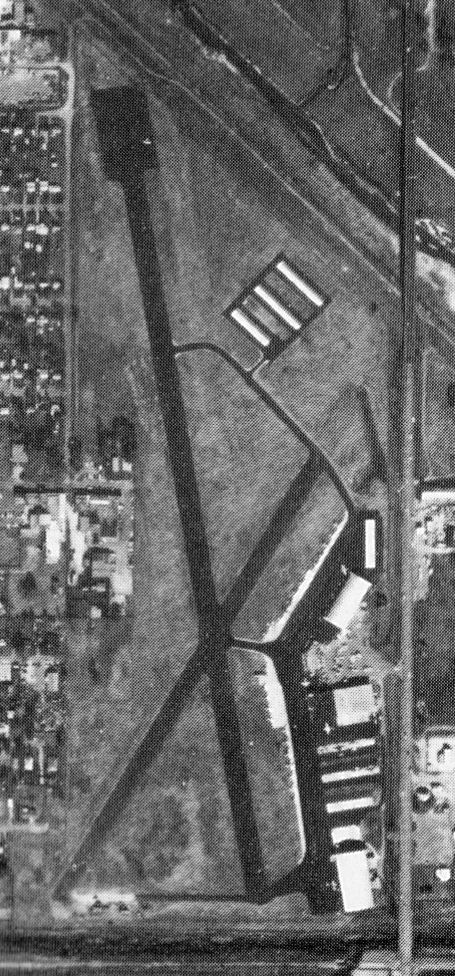
The earliest aerial view which has been located of Downtown Airpark was an undated photo from the 1978 OK Airport Directory (courtesy of Frank Holbert).
It depicted Downtown Airpark as having 2 asphalt runways, with numerous hangars on the east side.
In April 1985, Mayor Andy Coats proposed that the airpark be acquired by the city via condemnation or other procedures
and that it become the site of a new racetrack facility.
Luckily that plan did not come to pass.

The 1986 USGS topo map depicted Downtown Airpark as having 2 paved runways, taxiways, and several hangars along the east side of the field.
A 7/11/87 Oklahoman article said that Downtown Airpark claimed to have the largest Commander parts inventory in the world.
The airpark's connection with Aero Commander was significant enough for it to host a reunion in 1995.
A 6/16/95 Oklahoman article reported that "Dozens of venerable twin-engine 'Aero Commander' aircraft
are expected as far away as Germany, Australia & Sweden for the inaugural meeting
of the 'Twin Commander Flight Group' today at Downtown Airpark.
Defense attorney F. Lee Bailey, also a twin-Commander flier, is expected for the gathering."
Downtown Airpark employed more than 140 people in the mid-1990s,
according to an 6/1/05 Oklahoman article by Steve Lackmeyer & Julie Bisbee.
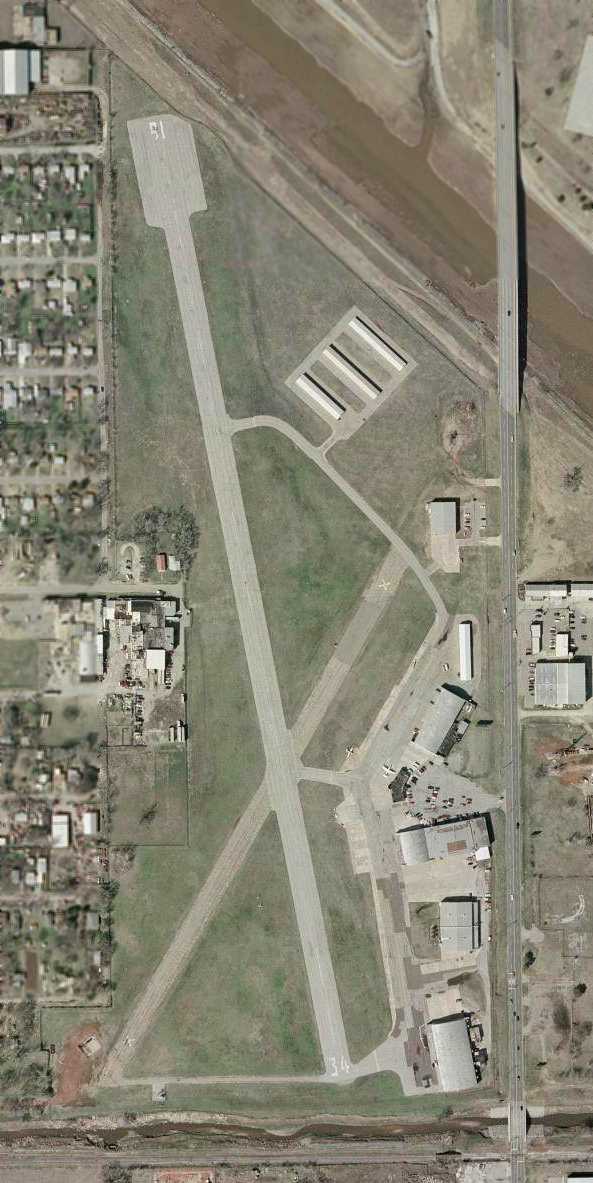
A March 2002 aerial view depicted Downtown Airpark in its last years.

A closeup from the March 2002 aerial view, showing the only 2 aircraft visible on the field at Downtown Airpark.
Downtown Airpark recorded 7,500 landings & takeoffs per year from 3/03-3/04,
according to an 6/1/05 Oklahoman article by Steve Lackmeyer & Julie Bisbee.
A 6/2/05 Oklahoman article, "Left on the Ground," described the beginning of the end.
The airpark closed the day earlier, the owners (members of the Amis family) telling employees "not to come back."
The article quoted Dave Amis III, grandson of co-founder W.D. Amis,
as saying, "We tried to stick it out [after the 9/11 terrorist attack in New York City], and we made a gallant go of it."
Airplane owners storing their planes there were sent looking for new space,
even though landings & takeoffs continued for a time – but without refueling there.
Amis said, "This has been quite a 48 hours for my dad & me.
This business has been in our family for 58 years.
We're just sitting back taking a breather & not making a decision when we are emotional & stressed."

A 2005 photo by Doug Dawg looking northeast at the only aviation activity which remained at Downtown Airpark after its closure,
the Oklahoma City Police Department's hangar with an MD500 helicopter visible on the helipad.
Thomas Solinski reported in 2005, “The last known operators there are the OKC PD Helicopter branch (2 500Es & 1 C-182).
The OKC Downtown Airpark is not long for this world.
With the city damming up the North Canadian River, the land will probably go to tourist-related development.”

A circa 2005 aerial photo looking northeast at Downtown Airpark.

A circa 2005 photo of the entrance sign for the Downtown Airpark & its restaurant.
Despite the airpark's closure, the restaurant it housed lingered on for a time.
An 8/6/05 Oklahoman article described the plight of Lundy's Restaurant:
“The café, which has shared building space with the Downtown Airpark for nearly 51 years,
is still hanging on while the air airpark faces foreclosure.
But [Kay] Lundy plans to stay on until she's forced to shut down the restaurant.
Lundy's mother, Iva, started the restaurant at the Downtown Airpark when business in the area was bustling.
She redesigned the restaurant to include a counter so workers who only had 30 minutes for lunch could get their food quicker.”
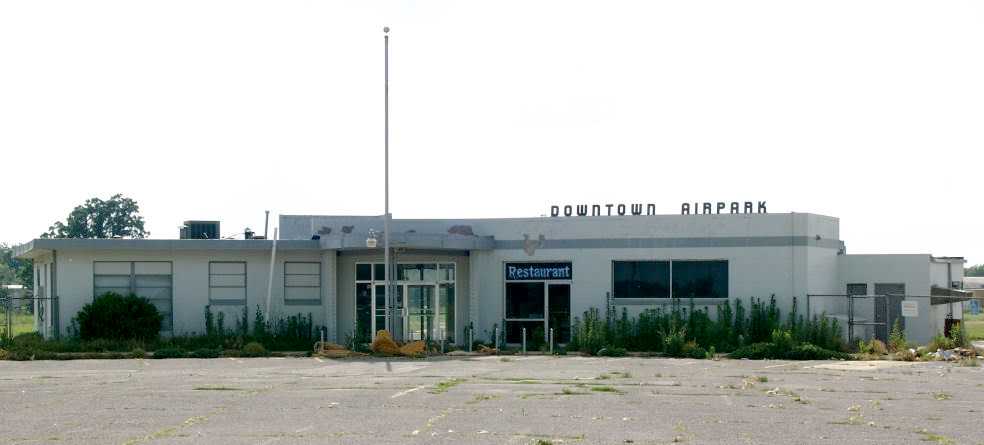
A 2005 photo by Doug Dawg looking west at the Downtown Airpark terminal & restaurant after its closure,
showing its stylish Art Deco lettering.

A 2005 photo by Doug Dawg looking south at a Downtown Airpark hangar, with remains of a demolished building in the foreground.
Some interest existed by the Seminole Tribe in acquiring the property to make it a casino,
but in a 11/19/05 Oklahoman article, the tribe's chief, Kelly Haney, described the notion as "far fetched."
In any event, that didn't happen.
A 12/8/05 Oklahoman article documented that the airpark was placed in receivership after accumulating more that $1.5 million in debt
and that various items of real & personal property owned by the airpark were to be sold for public auction.
In a 1/7/06 Oklahoman article, Julie Bisbee & Steve Lackmeyer noted that, “Speculators interested in turning the acreage
of a defunct airpark into a riverfront development got a nod Friday from a state judge overseeing the foreclosure case of the Downtown Airpark.
Judge Daniel Owens approved a motion that allows prospective buyers to make bids on the 81 acres of land just west of downtown Oklahoma City
to help pay off the debts of Downtown Airpark Inc.
The corporation owes more an $5 million to creditors.”
The article said that more than $193,000 was owed to employees when the airpark closed.
It also identified several interested bidders, including former Oklahoma City mayor Kirk Humphreys & his sons Grant & Blair.
The article concluded, “Jim Hasenbeck, a partner with Studio Architecture who did the master plan for the Oklahoma River,
has said that the airpark site is a prime development spot because of its view of the downtown skyline & proximity to the new Interstate 40 Crosstown Expressway.”
Finally, after initiating the purchase in February 2006, the property was acquired by Aduddell-Humphreys Partners for $7 million in November 2006,
according to a 11/11/06 Oklahoman article.
The article said that the partnership also included the Jim Brewer family & others.
A 11/30/06 article in the Journal Record opined about the new owners' options:
“Several options for the land have been discussed, including diverting the Oklahoma River to possibly establish shoreline.
Grant Humphreys has, however, said the property will be held for 3-5 years while Interstate 40 is realigned & a master plan is established.
Some of the uses the new owners have suggested include a mixed- use development as well as the possibility of a restaurant row & hotel.”
Jarrod Wilkening reported, “I used to spend a lot of time at that airport with my camera. Sad to see it go.”

A circa 2007 aerial view looking east at Downtown Airpark restaurant & hangars.
Jarrod Wilkening reported in 2009, “The city government is contemplating putting a casino there, but for now it sits abandoned.”

A 9/8/12 aerial view by Nick Newcomb looking west at Downtown Airpark, showing that the airport remains largely intact.
What a shame to see such nice aviation infrastructure simply ignored & unused.
A 2014 aerial view showed Downtown Airpark's runways & taxiways remained intact, but all buildings except for 2 had been removed:
the Oklahoma City Police Department's hangar on the northeast side (with an MD-500 helicopter parked outside),
and one other hangar remained on the southeast corner.
Don Williams reported in 2015, “Downtown Airpark has lost all its buildings & serves as a concert venue now.”
____________________________________________________
Shawnee Municipal Airport #2, Aydelotte, OK
35.44, -96.92 (East of Oklahoma City, OK)

Shawnee Municipal Airport #2, as depicted on the April 1944 Oklahoma City Sectional Chart (courtesy of Chris Kennedy).
In 1942 the Navy leased the Shawnee Municipal Airport from the City,
and insisted that the Regan Flying Service vacate the airport.
The Regan Flying Service had been operating a Contract Flying School for the Army with Piper J-3 Cubs.
The City purchased land 8 miles north of the existing airport & established Shawnee Municipal Airport #2,
according to “U.S. Naval Air Stations of WW2” by Mel Shettle.
Shawnee Municipal Airport #2 was evidently opened at some point between 1943-44,
as it was not yet depicted on the February 1943 Oklahoma City Sectional Chart (according to Chris Kennedy).
The earliest depiction which has been located of Shawnee Municipal Airport #2
was on the April 1944 Oklahoma City Sectional Chart (courtesy of Chris Kennedy).
It depicted “Shawnee No 2” as a commercial/municipal airport.
The April 1, 1944 US Army/Navy Directory of Airfields (courtesy of Ken Mercer)
listed “Shawnee #2” as having a 2,900' unpaved runway.
“Shawnee No 2” was still depicted as a commercial/municipal airport
on the 1945 Oklahoma City Sectional Chart (courtesy of John Voss).

A circa 1942-45 aerial view looking north at Shawnee Municipal Airport #2
from the 1945 AAF Airfield Directory (courtesy of Scott Murdock)
depicted the field as having 3 grass runways, with a large hangar on the northeast side of the field.
Shawnee Municipal Airport #2 was evidently closed (for the 1st time) at some point between 1945-46,
as it was no longer depicted on the September 1946 Oklahoma City Sectional Chart (according to Chris Kennedy).
Shawnee Municipal Airport #2 was evidently reopened at some point between 1946-48,
as it was listed in the August 31, 1948 Airman's Guide (according to Chris Kennedy).
It described Shawnee Municipal Airport #2 as having 4 unpaved runways, with the longest being 2,900'.

The last aeronautical chart depiction which has been located of Shawnee Municipal Airport #2
was on the March 1949 Oklahoma City Sectional Chart (courtesy of Chris Kennedy).
It depicted “Shawnee No 2” as having a 2,900' unpaved runway.
Shawnee Municipal Airport #2 was evidently closed (again) at some point between 1949-54,
as it was no longer depicted on the August 1954 Oklahoma City Sectional Chart (according to Chris Kennedy)
nor on the 1954 USGS topo map.

A 4/6/64 USGS aerial view of the site of Shawnee Municipal Airport #2 showed the 2 hangars on the east side.
The airfield on the west appeared to have a single northeast/southwest runway.
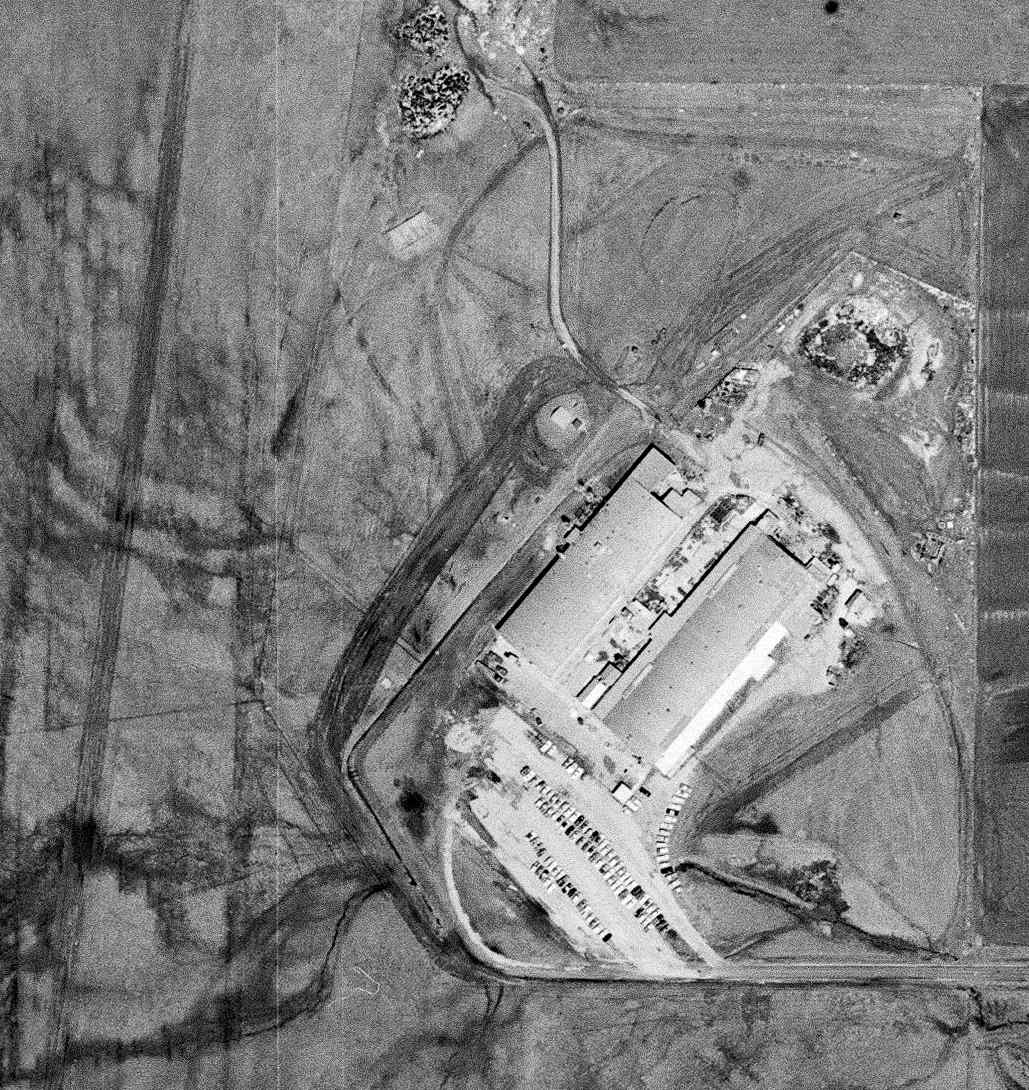
A close-up from the 4/6/64 USGS aerial view of the site of Shawnee Municipal Airport #2 showed the 2 hangars to be evidently reused for some non-aviation purpose.
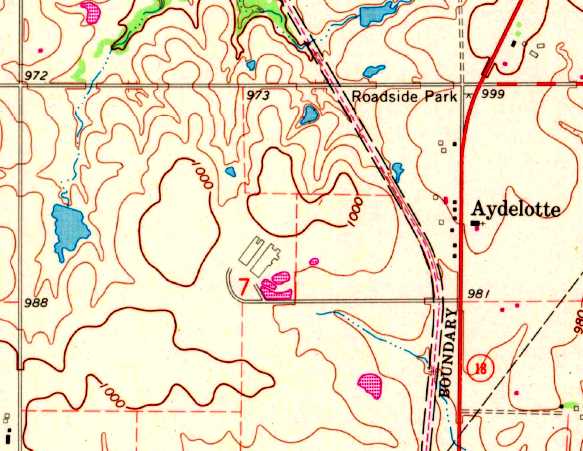
The 1967 USGS topo map depicted the 2 large hangars, the largest being 400' long.
It did not depict any runways or other features, and did not label the site at all.
The 1979 USGS topo map depicted the 2 hangars in the same fashion as depicted on the 1967 topo map.
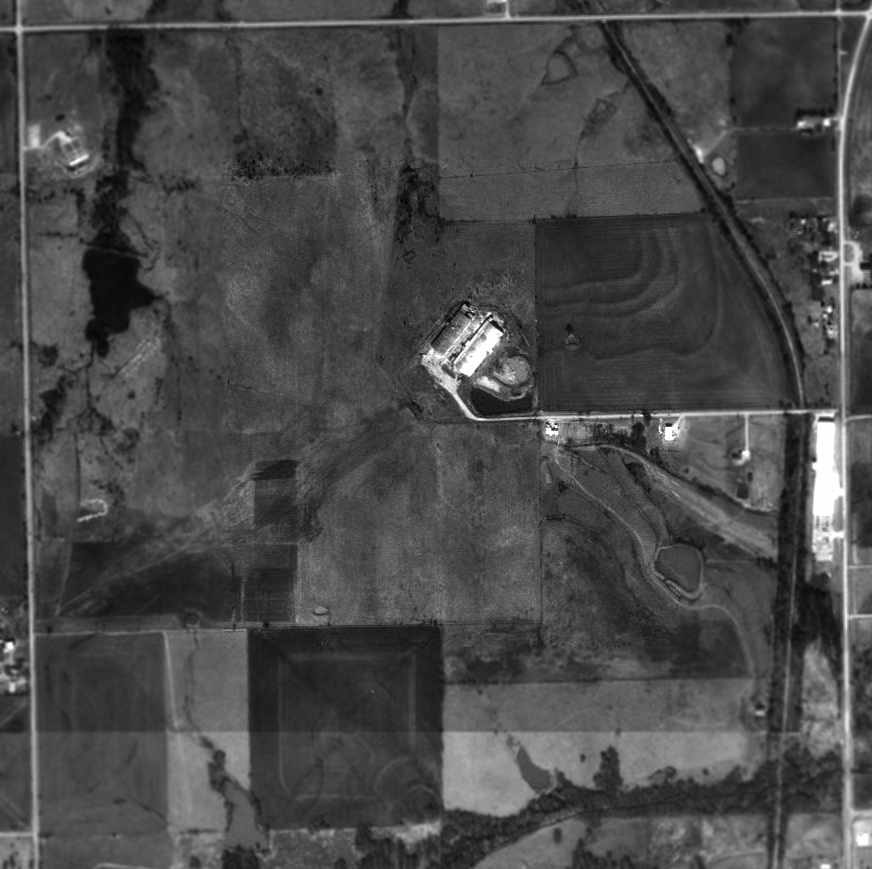
The 2 former hangars of Shawnee Municipal Airport #2 were visible in the 1995 USGS aerial photo.

A March 2003 aerial view by Steve Link looking southwest at the site of Shawnee Municipal Airport #2.
Steve observed that there do not appear to be any trace of the former runways recognizable from the air.

A March 2003 aerial view by Steve Link looking northeast at the 2 former hangars at the site of Shawnee Municipal Airport #2.
Steve reported, “Though abandoned, the 2 huge hangars are still there.
I took these pics from my Citabria & it looks like they are still used as some kind of storage.”

A 2014 aerial view looking north at the site of Shawnee Municipal Airport #2, showing that the 2 big hangars remain standing,
and the airfield area to the west of the hangars remains clear.
The site of Shawnee Municipal Airport #2 is located at the western terminus of Jonco Road, a half-mile west of Route 18.
____________________________________________________
Curtiss-Wright Field / (Original) Wiley Post Airport, Oklahoma City, OK
35.57, -97.57 (Northwest of Downtown Oklahoma City, OK)

A 1934 photo (courtesy of Jeff Wilkinson) of the Winnie Mae on the ground at Curtiss-Wright Field.
The original name of this airport was Curtiss-Wright Field.
It was located north of Oklahoma City, near the Bluff Creek Reservoir (later known as Lake Hefner).
Curtiss-Wright Field was established in 1928 (according to Kristopher Crook).
According to Jeff Wilkinson, in 1928, "a hangar was built to showcase Curtis-Wright products.
Wiley Post the aviator used that hangar from 1929 until his death in 1935 for his own projects."
Curtiss-Wright was also the original base for Braniff Airways (according to Kristopher Crook).
"Braniff was based at Curtiss-Wright throughout the 1930's, maintaining operations at the field
even after the opening of the Municipal Air Terminal (now Will Rogers World Airport) in 1932."

A 1935 photo looking northeast at a Curtiss Wright Flying Service hangar (courtesy of Thomas Solinski).
Thomas observed, “To my best estimation those are Fairchild Model 24-C8As, Cs and possibly the then-new Ds.”

The December 1935 Oklahoma City Sectional Chart (courtesy of Chris Kennedy)
depicted Curtiss Wright as a commercial or municipal airport.
The Airport Directory Company's 1937 Airports Directory (courtesy of Bob Rambo)
described Curtiss-Wright Field as a commercial airport with a 2,640' square landing area.
According to Jeff Wilkinson, the field was sold to Mr. John Burke in 1940.

The field had been renamed Wiley Post Airport by 1941,
as that is how it was listed in The Airport Directory Company's 1941 Airports Directory (courtesy of Chris Kennedy).
This aerial photo from the directory looked northwest at the field.
The directory described Wiley Post Airport as consisting of a 2,640' square grass area,
and one of 2 buildings (hangars?) were depicted along the east side of the field.
The April 1944 US Army/Navy Directory of Airfields (courtesy of Ken Mercer)
described Wiley Post Airport as having a 3,000' unpaved runway,
and indicated that Navy flight operations were conducted from the field.
Jim Shaw recalled, “I remember Wiley Post well.
I grew up 3 blocks south & one block east of the intersection of May Avenue & Britton Road, (the southeast corner of the field).
Dad used to tell stories of me toddling around the yard (1944-45), constantly looking up at the yellow Navy PT-13s
that were constantly overhead & repeatedly falling on my face as I wasn't watching where I was going.”

The March 1945 Oklahoma City Sectional Chart (courtesy of Jeff Wilkinson)
depicted Wiley Post as a commercial or municipal airport.
It also showed that the Bluff Creek Reservoir had been constructed adjacent to the west side of the field
(note the reservoir was not present on the 1935 chart).

As depicted on a 1949 street map (courtesy of Jeff Wilkinson),
Wiley Post Airport was bounded by Britton Road to the south & May Avenue to the east.

The last aeronautical chart depiction which has been located of the original Wiley Post Airport was on the 1949 OK City Sectional Chart (courtesy of John Price),
which depicted Wiley Post as having a 3,200' unpaved runway.

An aerial photo looking west at the original Wiley Post Airport from the 1950 OK Airport Directory (courtesy of Chris Kennedy).
The directory described Wiley Post as consisting of a 2,640' "allway" field, which offered major repairs, fuel, and hangars.
The manager was listed as John Burke.

A circa 1950 photo looking southeast at the ramp of the original Wiley Post Airport,
showing Mooneys, Bonanzas, a Navion, a Piper, and Cessnas (courtesy of Wesley Horton).

The 1951 USGS topo map depicted Wiley Post Airport as an open field with several buildings along the east side.
Jim Shaw recalled, “I remember one incident (I think I was still in grade school),
when a bootlegger overloaded his plane & attempted to takeoff to the south after dark.
He got off the ground, but failed to clear the line of trees on the south side of Britton Road.
Word spread throughout the neighborhood like wildfire & all the dads rushed to the scene
(bear in mind that Oklahoma still had prohibition until 1959).
Everything that wasn't broken was cleaned out before the police arrived. I don't know what became of the bootlegger.
The Goodyear blimp always operated out of Wiley Post whenever it was in OKC,
and I remember a Navy blimp or two there on occasion.”

A circa 1953-55 aerial photo looking east at Wiley Post's hangar,
with 4 single-engine aircraft parked to the right (courtesy of Charlie McClure).

The last photo which has been located of the original Wiley Post Airport was a 6/24/54 USGS aerial view.
It depicted a total of 8 light single-engine aircraft parked on the east side of the field, near the main hangar on which was painted “Howdy, Wiley Post Airport”.
According to Jeff Wilkinson, Wiley Post Airport was closed in 1955.
“I can imagine that what led to the closure was the nearby Tulakes Airport,
built in 1942 as an auxiliary to the Army's Will Rogers Field located at the Oklahoma City Municipal Airport
[Tulakes Airport eventually became known as the current Wiley Post Airport].
The field was subsequently developed into a residential neighborhood.”
The original Wiley Post Airport was no longer depicted on the 1965 OK City Sectional Chart (courtesy of John Price).
According to Jeff Wilkinson, the hangar built at the field in 1928 by Curtiss-Wright Company
was in 1960 converted into a shopping center & then a church.
According to Christopher Crook, a car dealership occupies the southeast portion of the former airport site.
The 1991 USGS aerial photo showed that the location of the original Wiley Post Airport
had been redeveloped with housing.

The location of the original Wiley Post Airport has been superimposed over the 2002 USGS aerial photo by Jeff Wilkinson.
According to Jeff Wilkinson reported in 2004 that the 1928-vintage former hangar
had "stood empty for a time when it was purchased by the auto dealership located nearby.
The dealer wanted to demolish the building,
but (thanks to the intervention of a group of pilots) the hangar was carefully dismantled.
An area of the current Wiley Post Airport has been dedicated for the reconstruction of the hangar.
It will be reconstructed to be historically accurate, but up to modern standards."
____________________________________________________
(Original) Ardmore Municipal Airport, Ardmore, OK
34.3 North / 97.15 West (North of Dallas, TX)

The original Ardmore Municipal Airport,
as depicted on the December 1935 OK City Sectional Chart (courtesy of Chris Kennedy).
The original municipal airport for the town of Ardmore was located north of the town.
The date of construction of Ardmore Airport has not been determined.
It apparently dated back to before 1934,
as it was listed as CAA Intermediate Site 10 on the Fort Worth-Wichita Airway
in the 1934 Department of Commerce Airfield Directory (according to Chris Kennedy).
It was described as having 2 sod runways,
with the longest being a 3,900' northwest/southeast strip.
The earliest depiction of the Ardmore Municipal Airport which has been located
was on the December 1935 OK City Sectional Chart (courtesy of Chris Kennedy).
The Airport Directory Company's 1937 Airports Directory (courtesy of Bob Rambo)
described Ardmore Airport as being the Department of Commerce's Site 10 along the Fort Worth - Wichita Airway.
It was described as having 2 sod runways, with the longest being a 3,900' northwest/southeast strip.
A hangar was said to be at the field.
Ardmore was described in the same manner
in The Airport Directory Company's 1938 Airports Directory (according to Chris Kennedy).
The runway at Ardmore was evidently paved at some point between 1937-44,
as the 1944 US Army/Navy Directory of Airfields (courtesy of Ken Mercer)
described the field as having a 4,000' hard-surface runway.

A circa 1942-45 aerial view looking north from the 1945 AAF Airfield Directory (courtesy of Scott Murdock)
depicted Ardmore Intermediate Field as having a single paved northwest/southeast runway,
with a building along the east side.
The 1944 OK City Sectional Chart (courtesy of Chris Kennedy)
depicted both the original Ardmore Municipal Airport (north of the town of Ardmore)
as well as the newer Ardmore AAF (to the east).
The 1945 AAF Airfield Directory (courtesy of Scott Murdock) described Ardmore Intermediate Field
as a 168 acre irregularly-shaped field having a 4,000' asphalt northwest/southeast runway & 3 sod runways.
The field was said to have a single 120' x 60' metal hangar,
to be owned by the City of Ardmore, and operated by the Civil Aeronautics Bureau.
Billie Jo recalled of Ardmore, “My father-in-law, Max Jones, used to operate the airport.
He has many fond memories of those years.”
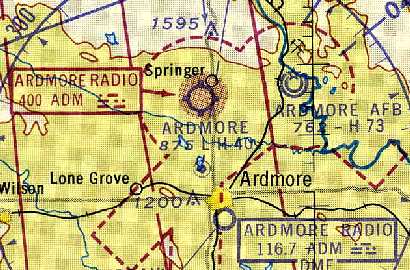
Ardmore was still an active airport in 1959,
as it was depicted on the 1959 Wichita Mountains World Aeronautical Chart (courtesy of Chris Kennedy).
However, the field was apparently closed within the next year,
as it was labeled "Ardmore (abandoned)" on the 1960 OK City Sectional Chart (courtesy of Chris Kennedy).
By that time, the much larger Ardmore AFB (a few miles to the east)
had been vacated by the military, and had become the new Ardmore Municipal Airport.
Rob Lucy recalled, “My grandfather had a livestock operation across the street to the north of old Ardmore Field.
During visits as a youth, I was always intrigued by the place.
My grandmother, who grew up in the area, would only say that everything moved to 'the base'.
Unfortunately, having openly declared my curiosity,
my grandmother put the place off limits thus ensuring that I would live long enough to send this note.
I had to find more agrarian ways to get into trouble.
However, I can say that I recall an occasional hangar queen aboard in the 1960’s -
but I never observed anything move or make noise.
Also, I can verify there was a turf landing zone or taxiway roughly parallel to US77
and a turf ramp just north of the hangar.
The place was pretty much a ghost town.”
By the time of the 1964 USGS topo map,
the abandoned former runway of the original Ardmore Municipal Airport was labeled "Drag Strip".

In a 1995 USGS aerial view looking north, the former runway & parallel taxiway of the original Ardmore Airport still remained in quite good condition.
It was not apparent from the photo whether the site is still actively reused as a drag strip.
According to Kristopher Crook, the building at the northeast corner of the field was a former hangar.
"Ardmore apparently also had a north-south turf runway
(at least, I've never been able to confirm if it was ever paved, though)
that ran to the west of the building in the picture.
The hangar is still in use today [2003],
and easily visible from US 77 & Brooks Road (77 is the road to the east).
I believe it is now used by the city of Ardmore for equipment storage."
According to Chris Kennedy, the site of the former Ardmore Airport
is still labeled as a "Drag Strip" on the 2003 Sectional Chart.

A 2/24/12 aerial view looking northwest along the former runway of the original Ardmore Airport, reused as a drag racing strip.
The site of the original Ardmore Airport is located southeast of the intersection of Interstate 35 & Brooks Road.
____________________________________________________
Northeast 63rd Street Airport / Expressway Junction Airpark (2EJ, 120K),
Oklahoma City, OK
35.54, -97.45 (Northeast of Downtown Oklahoma City, OK)
"Northeast" Airport, as depicted on the 1960 OK City Sectional Chart (courtesy of Chris Kennedy).
Northeast 63rd Street Airport was evidently built at some point between 1956-60,
as it was not depicted on the 1955 Oklahoma City Sectional Chart (according to Chris Kennedy) nor the 1956 USGS topo map.
Anne Lynch recalled, “That airport was near my childhood home at Lake Aluma.
A vivid childhood memory is of my uncle's airplane in the creek bed just to the south of the airport.
My uncle, Ray Lynch, flew a Navion. In the late 1950s, he tried to abort a landing but clipped the power lines along 63rd Street.
After spinning around a bit, the plane came to rest upright in the creek bed facing north. No one in his family was injured – amazingly.
We could see the not-too-damaged plane from our living room.
You can see in the photographs that the power line was then moved some distance further south to prevent further such accidents.”
The earliest depiction of this field which has been located
was on the 1960 OK City Sectional Chart (courtesy of Chris Kennedy).
It described "Northeast 63rd Street" Airport as having a single 2,700' turf runway.
Northeast 63rd Street Airport was subsequently renamed Expressway Junction Airport.
According to the obituary of James Adair in the 11/2/14 Daily Oklahoman (courtesy of Anne Lynch),
"Jim's fear of flying turned into a lifelong passion when he learned to fly in his twenties.
In 1960, he built Expressway Airpark in OKC, turning a bootlegging grass strip into a legitimate airport, where many private pilots shared their love of flying."
The 1962 AOPA Airport Directory described Expressway Junction Airport as having a single 3,000' paved Runway 4/22,
and listed the operator as Expressway Junction Airport.

"Expressway Airpark", as depicted in the 1963 OK Airport Directory (courtesy of Chris Kennedy).
The directory described the field as having a single 3,000 asphalt Runway 3/21.
Four hangars were depicted on the west side of the runway.
The airport appeared quite well-used, with at least 16 aircraft visible on the field in the aerial photo.
The operator was listed as Estel Husted.
Expressway Junction Airport, as depicted on the 1967 OK City Sectional Chart (courtesy of Chris Kennedy).

The 1969 USGS topo map depicted Expressway Junction Airpark as having a single northeast/southwest paved runway, with several buildings on the west side..
A 1971 airport directory (courtesy of Chris Kennedy) depicted Expressway as having a single 3,000' paved Runway 3/21,
with a ramp west of the runway, with a total of 4 hangars.
Jim Carter recalled, “In 1972-73 I flew a Lake LA-4 amphibian out of Expressway for Aero-Flight as in instructor.
We also flew Cherokee 140s & a Cherokee 180 for an instrument trainer.
The field had a very active contingent at the time with a waiting list for hangar space.
I think all we were using the 2/20 strip at the time
because the taxiway that had been built parallel to [Runway] 3/21
intersected the active runway such that the last 300’ or so were on the runway itself.
There was also a Lockheed Lodestar that operated out of the field at the time
so the strip was in pretty good shape to support an aircraft that size.
The towers to the west have been there for years.
When we made an instrument departure and needed a westerly heading
we were always given a climb to enroute clearance that included a 270 degree turn to the east.
This kept us out of the OKC & Wiley Post inbound traffic flow & kept us from hitting those man-made mountains.”
In the 1982 AOPA Airport Directory (courtesy of Ed Drury),
Expressway Airpark was described as having a single 3,000' paved Runway 2/20.
The operator was listed as Aero Flite Inc.
The airfield layout of Expressway Junction Airport, from a 1986 airport directory (courtesy of Chris Kennedy).
Note that by comparing the runway layouts from the 1971 & 1986 airport directories (courtesy of Chris Kennedy),
it may be seen that the previous Runway 3/21 was replaced by a slightly reoriented Runway 2/20.
The remains of the previous runway were still apparent in the diagram from the 1986 directory.
A parallel taxiway had also been constructed, as well as 2 more hangars.

In a 1990 USGS aerial view looking northwest, Expressway Junction Airport appeared to be fairly well-used,
with a total of at least 15 aircraft visible parked outside,
in addition to having 6 hangars.
According to Kristopher Crook, “Back in the early 1990s,
then-Governor David Walters proposed having the state purchase the airport
and make it the base for the state's aircraft fleet.
The airport was far closer to the State Capitol than Will Rogers or Wiley Post,
which is where the state's aircraft have been based over the years.
However, the runway was considered too rundown, too narrow, and too short
for the King Air that was being used at the time as the Governor's plane.
There was some talk of the runway being extended to 5,000' to provide the extra safety margin,
but bridging or rechannelling the creek to the north was deemed too expensive
and the whole idea was quickly dropped.”
At some point Expressway Junction ceased to be a public-use general aviation airport.
Kristopher Crook observed in 2003, "Expressway Junction Airpark is now mostly abandoned,
though the runway remains for emergency use.
The hangars have been taken over as some sort of church camp,
I'm not clear as to the specific use. Most of it is still visible."
The published statistics for Expressway Junction in the 2003 Airport Facility Directory
tell a story of an airfield that is well on its way to being closed.
The single runway, 2/20, is listed as being 3,350' long & asphalt,
but its condition is listed as "In Poor Condition Cracking; Asphalt Breaking Up."
Just about every other aspect of the airport's condition is listed with significant problems:
"Runway Edge Markings: Markings & Centerline Faded - Poor Condition.
Rotating Beacon Out of Service Indefinitely.
Parallel Taxiway Closed Indefinitely.
Runway 20 Obstacle Free Zone Contains Much Debris (Broken Concrete/Rocks).
A total of 16 aircraft were listed as still being based on the field,
but that was doubtful, given the long list of woes described for the airport.
The owner & manager are listed as John A Sabolich,
but the AFD also includes the remark, "Owner Desires Airport Not Be Charted."
Blake Bowers reported in 2003, "Some of the old hangers are used by a bible school,
but the main hanger, and FBO building are now used by AirEvac Lifeteam, out of West Plains, MO.
They use this as a regional headquarters for their OK, KS, and TX operations.
They fly their choppers,
and KCPD flys their choppers into there from time to time go across the street & get ice cream cones at Braums.
AirEvac has flown some fixed wing in there also.
AirEvac is trying to upgrade the place, taking bids on fixing the lights & all."
Blake continued, "Dr. John Sabolich purchased the airport as a place to race his cars, and for a while this was very popular,
but his fantastic advances in the field of prosthetics has taken up his time,
so he does not mess with the airport anymore.
Only one fixed wing is based there,
I don't believe it has flown since the FBO closed,
it supposedly belongs to the widow of the old owner, and she does not care to deal with it.
It just sits out there in the field - a [Cessna] 152 I think."
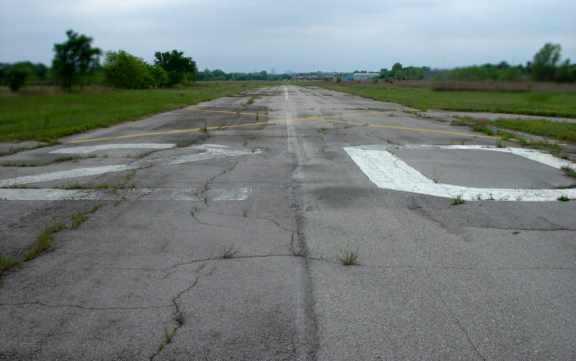
A 2005 photo by Keith Wood looking along Expressway Junction Airport's Runway 20.
Keith Wood visited Expressway Junction Airport in 2005.
He reported: “I've never been anywhere which reminded me so much of the early scenes in '12 O'Clock High!'
when Harvey Stovall (Dean Jagger) is looking at the abandoned runway at Archbury.
All that was missing was the cows on the runway.

A 2005 photo by Keith Wood of a windsock which remains intact at Expressway Junction Airport.
Keith continued, “I found no tiremarks on the runway.
Another windsock frame is on the opposite side of the runway [opposite side from the intact windsock pictured above].
The runway & taxiway were resurfaced at least once.
The surface is in good condition, except for the grass growing up through it.”
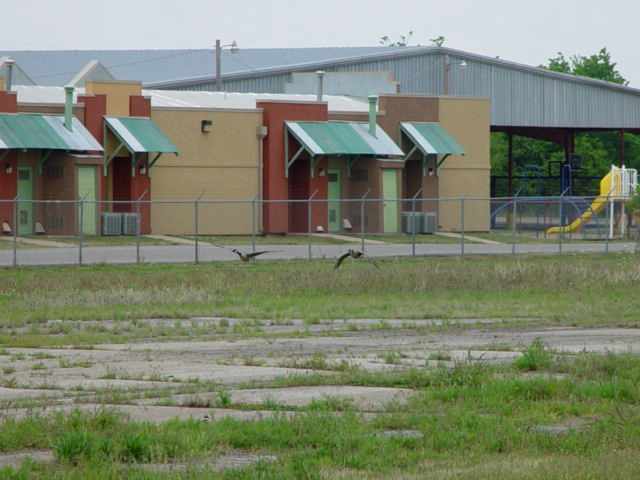
A 2005 photo by Keith Wood of former hangars at Expressway Junction Airport, now reused for a school.
Keith continued, “The buildings shown in the 1990 overhead are still there.
The long hangars are now classrooms for a private, church-run school,
and the large roof to the north of them is an open area.
The tiedown areas to the north of the hangar area are now fenced off
and there is debris & old appliances dumped there.
The small pad opposite the southern hangars was the original helipad.
The white-roofed hangar belonged to the Cessna dealer, and now houses the air-evac operation.
All of the other buildings are part of the church school.”
Keith continued, “As can be seen by the runway pics, approach & departure were unobstructed,
and the only air traffic that I saw during the whole hour that I spent there were birds.
However, just across Interstate 35 to the west were over a dozen very tall broadcasting towers.
There was no sign of major population pressure... the place is just closed.
I saw no aircraft of any type.”

A circa 2006 aerial view looking north at the hangars & runway at the former Expressway Junction Airpark.

An 8/9/12 aerial photo looking northeast at Expressway Junction Airpark.
Expressway Junction Airpark is located east of the intersection of Interstates 35 & 44.
____________________________________________________
Since this site was first put on the web in 1999, its popularity has grown tremendously.
That has caused it to often exceed bandwidth limitations
set by the company which I pay to host it on the web.
If the total quantity of material on this site is to continue to grow,
it will require ever-increasing funding to pay its expenses.
Therefore, I request financial contributions from site visitors,
to help defray the increasing costs of the site
and ensure that it continues to be available & to grow.
What would you pay for a good aviation magazine, or a good aviation book?
Please consider a donation of an equivalent amount, at the least.
This site is not supported by commercial advertising –
it is purely supported by donations.
If you enjoy the site, and would like to make a financial contribution,
you
may use a credit card via
![]() ,
using one of 2 methods:
,
using one of 2 methods:
To make a one-time donation of an amount of your choice:
Or you can sign up for a $10 monthly subscription to help support the site on an ongoing basis:
Or if you prefer to contact me directly concerning a contribution (for a mailing address to send a check),
please contact me at: paulandterryfreeman@gmail.com
If you enjoy this web site, please support it with a financial contribution.
please contact me at: paulandterryfreeman@gmail.com
If you enjoy this web site, please support it with a financial contribution.
____________________________________________________
This site covers airfields in all 50 states.